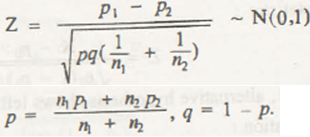Testing of Proportions
While dealing with proportions in statistics, it is imperative that you should remember that there will be a hypothetical situation and research questions that are mostly answered will have hypothesis test for a single proportion.
A test of proportion is used for assessing whether a specific sample is representative of the true proportion from an entire population. To deal with this, both Critical Value and P-Value approach is used.
How to conduct it?
- There is a simple random sampling method that is available
- Sample has to include at least 10 successes and failures
- Population size has to be 20 times of the actual sample size
- There are specifically 2 outcomes that are attributed to this sample: Success and Failure
There are 4 steps that are to be found here:
- Initially the hypotheses has to be stated
- Next an analysis plan has to be formulated
- Next the available sample data has to be analyzed against the new backdrop
- Final results are to be interpreted and sample population has to be found.
Here are sums to give you a proper idea of this process.
Links of Previous Main Topic:-
- Introduction to statistics
- Knowledge of central tendency or location
- Definition of dispersion
- Moments
- Bivariate distribution
- Theorem of total probability addition theorem
- Random variable
- Binomial distribution
- What is sampling
- Estimation
- Statistical hypothesis and related terms
Links of Next Statistics Topics:-
- Analysis of variance introduction
- Definition of stochastic process
- Introduction operations research
- Introduction and mathematical formulation in transportation problems
- Introduction and mathematical formulation
- Queuing theory introduction
- Inventory control introduction
- Simulation introduction
- Time calculations in network
- Introduction of game theory





























